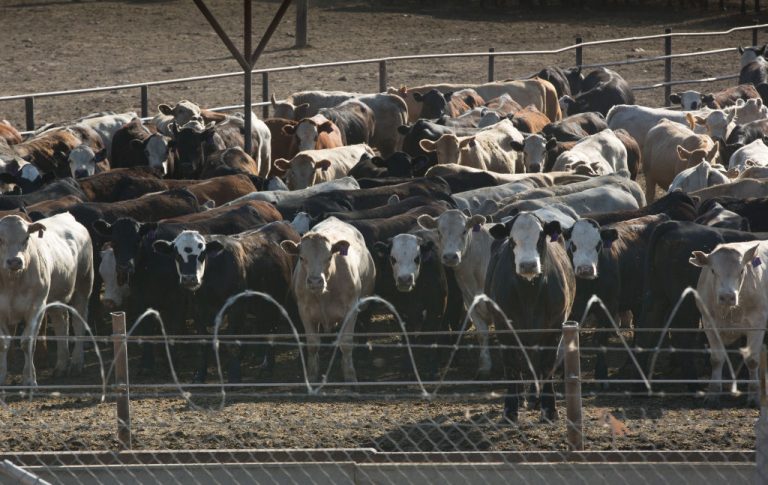The size of the nation’s cattle herd has contracted to levels not seen since 2016 and 2012 amid a number of coinciding crises, such as spiraling feed costs, water shortages, and unprecedented temperatures.
But most concerning about the statistic is that farmers are sending large amounts of their breeding stock to feedlots where they will be prepared for slaughter.
The U.S. Department of Agriculture released their national Cattle Report on July 22, comprising data current as of July 1. While overall, data shows that the national herd is down only 2 percent compared to 2021, this number composes more than 2 million cows.
The total count of all cattle and calves as of July 1 was 98.8 million, down from 101 million year over year.
MORE ON FOOD CRISIS AND COLLAPSING CLIMATE
- Avian Flu Sends US Egg Laying Chicken Flock To Lowest Levels Since 2015
- City in New Mexico Only Has 50 Days of Water Remaining, Declares State of Emergency
- World’s Top Producer of Ammonia, a Key Component in Fertilizer, Slashes Production Amid German Energy Crisis
- New NASA Images Reveal the Slow Death of Lake Mead, Which Nourishes 60 Percent of US Agriculture
Cows and heifers who have calved amount to 39.8 million head, beef cows 30.4 million head, and milk cows 9.45 million, the data showed.
Success
You are now signed up for our newsletter
Success
Check your email to complete sign up
In statements made during an agency radio report on July 26, USDA livestock analyst Shayle Shagam revealed a key trend in the data that does not appear in the USDA report when he said, “We are seeing large numbers of female stock have been placed in feedlots.”
According to the Alberta Cattle Feeders’ Association website, a feedlot is a penned area where cattle are held and fed for the purpose of focusing “on efficient growth and weight gain,” while “reducing the need for cattle to forage for food.”
The detail is notable, as the USDA data states that the number of cattle on feedlots totals 13.4 million, but is unchanged since 2021.
Additionally, the report stated that the 2022 calf crop is expected to be down 1 percent from 2021 at 34.6 million head.
Shagam added that the combination of females being sent to feedlots to be primed for slaughter in addition to a declining calf crop obviously means “supplies of cattle going to feedlots is going to be declining.”
The implication being that 2023 will face “progressively tighter supplies of all fed cattle available for slaughter.”
CEO of the National Cattleman’s Beef Association, Colin Woodall, told Fox Business that the problem is rooted in drought.
“There’s no place to go because everybody is struggling to find the forage they need to feed their cattle,” he said.
Woodall added that although consumers can expect food prices to continue to rise as a result of the crisis, “Everybody has to remember that it’s not cattle producers setting that price.”
“It’s all about costs. When you look at those who make a decision to send their cattle to market to either thin down their herd or completely eliminate their herd, it is always going to be attributed to the increase of their input costs.”
The CEO elaborated, “And that is everything from the cost of feed, cost of hay and cost of diesel for tractors, diesel for the truck, fertilizer costs. And there’s so many things that go into producing cattle that the producers just don’t have any control over.”
California, for example, is facing an unprecedented and prolonged drought in its Central Valley area, which is responsible for a quarter of U.S. food production.
Because of the lack of water, some 800,000 acres of farmland, amounting to roughly 1,250 square miles, stands unused this year, according to a California Department of Food and Agriculture-funded study conducted by University of California Merced researcher Josue Medellin-Azuara.
The figure is up at least double from 2021’s idled farmland.
Local dairy farmers in the area have stated that a lack of available water to keep their cattle both hydrated and cool means they face the difficult prospect of sending their herd to slaughter.
Ryan Junio, owner of Central Valley dairy farm Four J Jerseys, told the publication Daily Herd Management on July 19 that water shortages were the erstwhile problem facing area farmers, much more so than the rising cost of feed.
Owner of a Missouri breeding operation, John Kleiboeker, explained the reality of the significance of breeding stock being sent to feedlots in preparation for slaughter for Fox viewers, “A heifer is two years old before she produces her first baby.”
“That calf is another 18 months after that. So you’re talking about close to 40 months from the time that little baby heifer is born until she has produced a pound of beef.”
Kleiboeker also illustrated the feed shortage issue, explaining that over the last five years his operation has purchased as many as 120 large round hay bales from a local farmer’s first cut.
This year, not only did the first cut only yield 57 bales in total, but the price doubled to $75 each.
Because of drought, there was no second cut. And while local farmers are hopeful there will be a third cut, in reality, they’re looking for alternative options to keep their animals alive.
The alternative options he explained, however, involve trucking in hay from 250 miles south. The added cost from contracting a trucker, Kleiboeker stated, was in the range of $1,200 to deliver only 30 bales.















